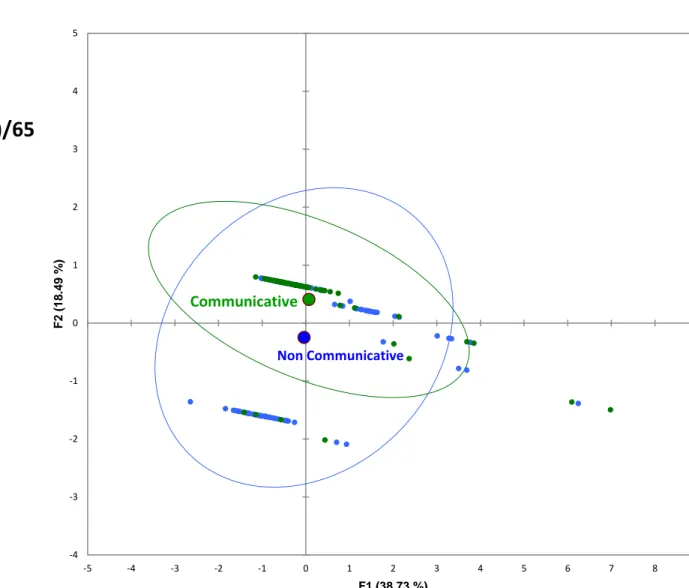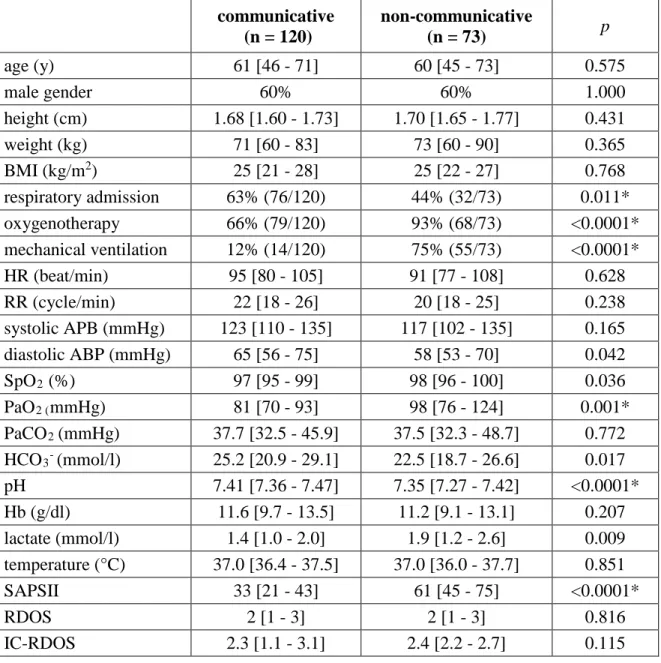HAL Id: hal-01688177
https://hal.sorbonne-universite.fr/hal-01688177
Submitted on 19 Jan 2018HAL is a multi-disciplinary open access archive for the deposit and dissemination of sci-entific research documents, whether they are pub-lished or not. The documents may come from teaching and research institutions in France or abroad, or from public or private research centers.
L’archive ouverte pluridisciplinaire HAL, est destinée au dépôt et à la diffusion de documents scientifiques de niveau recherche, publiés ou non, émanant des établissements d’enseignement et de recherche français ou étrangers, des laboratoires publics ou privés.
Observation scales to suspect dyspnea in
non-communicative intensive care unit patients
Alexandre Demoule, Romain Persichini, Maxens Decavele, Capucine
Morélot-Panzini, Frédérick Gay, Thomas Similowski
To cite this version:
Alexandre Demoule, Romain Persichini, Maxens Decavele, Capucine Morélot-Panzini, Frédérick Gay, et al.. Observation scales to suspect dyspnea in non-communicative intensive care unit patients. Intensive Care Medicine, Springer Verlag, 2018, 44 (1), pp.118 - 120. �10.1007/s00134-017-4934-6�. �hal-01688177�
Observation scales to suspect dyspnea
in non-communicative intensive care unit patients
Alexandre DEMOULE, M.D., PhD.1,2, Romain PERSICHINI, M.D.1, Maxens DECAVELE, M.D.1,2, Capucine MORELOT-PANZINI, M.D., Ph.D.1,2, Frédérick GAY, M.D., Ph.D.3*,
Thomas SIMILOWSKI, M.D., Ph.D.1,2* * The first last authors contributed equally to this work
(1) AP-HP, Groupe Hospitalier Pitié-Salpêtrière-Charles Foix, Service de Pneumologie et
Réanimation Médicale (Département "R3S"), F-75013, Paris, France
(2) Sorbonne Universités, UPMC Univ Paris 06, INSERM, UMRS1158 Neurophysiologie
respiratoire expérimentale et clinique, Paris, France
(3) AP-HP, Groupe Hospitalier Pitié-Salpêtrière-Charles Foix, Pôle Biologie Médicale et
Pathologie, Service de Parasitologie et Mycologie, F-75013, Paris, France
Correspondence:
Pr Alexandre DEMOULE
Department of Respiratory and Critical Care Medicine
Pitié-Salpêtrière Hospital
47-83 Bd de l’Hôpital
75651 Paris Cedex 13
France
Funding. This study was supported by “Association pour le Développement et l’Organisation
de la Recherche en Pneumologie et sur le Sommeil,” Paris, France, and by the program
“Investissement d’Avenir ANR-10-AIHU 06” of the French Government.
Competing interests. AD has signed research contracts with Covidien/Medtronic, Maquet,
Philips and Ait Liquide Santé; he has also received personal fees from Covidien/Medtronic,
Maquet, Resmed, Hamilton, Fisher & Paykel and MSD. TS has received grant research from
Coviden, Philips, Pierre Fabre Médicaments, Air Liquide Medical Systems; he has also
received personal fees from Takeda, Teva Pharma, Lungpacer Inc, Almirall France, Pierre
Fabre Médicaments, Novartis, Mundipharma, Invacare, Astra Zeneca, Boehringer Ingelheim
and GlaxoSmithKline. RP, FG, MD and CMP declare that they have no competing interests.
Dyspnea, like pain, is a major cause of physical suffering and emotional distress. In the
intensive care unit, mechanically ventilated patients are at high risk of dyspnea [1] and
increasing attention is given to this symptom [1, 2]. Because its evaluation relies on
self-report and self-assessment [3], dyspnea carries the risk of being underestimated or even
unrecognized and therefore unattended in many intensive care unit patients. This is
particularly so in patients unable to communicate with their caregivers (sedation, delirium ...).
We recently developed and validated a specific intensive care unit version of the respiratory
distress observation scale (IC-RDOS, http://www.ic-rdos.com) [4]. IC-RDOS, based on
respiratory and behavioural signs, correlates strongly with ratings of dyspnea on a visual
analogic scale in "communicative" patients, but this is by definition not the most pertinent
target population. The present secondary analysis describes IC-RDOS in
"non-communicative" intensive care unit patients, as the first step of its clinical and prognostic
evaluation in this setting.
The 120 communicative patients of the yet reported cohort were compared to 73
non-communicative patients (sedation, n = 49; delirium, n = 9; not understanding the
questions/instructions, n = 6; or another cause, n = 9) admitted during the same 4.5 months
period. Clinical data were gathered during the first 24 hours of the intensive care unit stay,
between 8 and 10 a.m. Based on the 21 observable variables with possible clinical relevance
(namely, to detect dyspnea) among the 120 communicative patients, the selection started with
a principal component analysis which identified 11 explanatory variables that mostly
contributing to the principal axes. These variables were entered into an iterative partial least
square regression process that ultimately identified 5 variables, of which the combination and
In the present principal component analysis, quantitative variables were centered and
reduced, binomial variables were treated as "0" or "1" in a quantitative manner, and the
"communicative/non-communicative" variable was treated as an illustrative variable not
participating in the building of the factorial analysis.
Expectedly, the non-communicative patients were, compared to the communicative
ones, more often mechanically ventilated, more often on supplemental oxygen, more acidotic
and had higher severity scores (Table SDC 1). Otherwise, their general characteristics were
roughly similar to those of the communicative patients. IC-RDOS values were not different in
both groups (2.3 [1.1-3.1] in the communicative patients, versus 2.4 [2.2-2.7] in the
non-communicative ones, p=0.115) although this result should be interpreted with caution since
this ancillary study was underpowered to address such comparison. These two
sub-populations as well as their corresponding centers of gravity were further plotted and
compared on the main factorial plan (F1 X F2) expressing 57.23% of the total inertia.
Beyond the similarity in IC-RDOS values, the projections of the two sub-populations
(communicative and non-communicative patients) first had very nearly centers of gravity,
second were geometrically congruent (Figure 1), attesting the homogeneity of the
communicative and non-communicative populations in terms of physical and behavioral
manifestations based on the five IC-RDOS variables.
These results suggest that IC-RDOS could be of value to identify non-communicative
intensive care unit patients experiencing dyspnea. This hypothesis will have to be verified, for
example by studies testing the responsiveness of IC-RDOS to interventions known to
alleviate dyspnea in the intensive care unit context [1], like this has been done for RDOS in
References
1. Schmidt M, Banzett RB, Raux M, Morelot-Panzini C, Dangers L, Similowski T,
Demoule A (2014) Unrecognized suffering in the ICU: addressing dyspnea in
mechanically ventilated patients. Intensive Care Med 40: 1-10
2. Chanques G, Nelson J, Puntillo K (2015) Five patient symptoms that you should
evaluate every day. Intensive Care Med 41: 1347-1350
3. Binks AP, Desjardin S, Riker R (2017) ICU Clinicians Underestimate Breathing
Discomfort in Ventilated Subjects. Respir Care 62: 150-155
4. Persichini R, Gay F, Schmidt M, Mayaux J, Demoule A, Morelot-Panzini C,
Similowski T (2015) Diagnostic Accuracy of Respiratory Distress Observation Scales
as Surrogates of Dyspnea Self-report in Intensive Care Unit Patients. Anesthesiology
123: 830-837
5. Campbell ML, Templin T, Walch J (2010) A Respiratory Distress Observation Scale
Figure 1. Panel A shows the calculation of the Intensive Care Respiratory Distress
Observation Scale (IC-RDOS). An IC-RDOS ≥ 2.4 predicted a visual analogic scale for dyspnea (D-VAS) of 4 or greater with equal sensitivity and specificity (72%) in
communicative patients. Panel B shows the comparison of the communicative and
non-communicative populations. Patients are plotted on the main factorial plan (F1XF2=57.23%
of the total inertia) from a principal component analysis build with the five variables of the
Figure 1
Non Communicative Communicative -2 -1 0 1 2 3 4 5 F 2 ( 18. 49 % )Variables
Score
0 –
3,3
1 – Heart Rate (beats/min)
+ (Heart rate)/65
2 – Use of neck muscles
during inspiration
if present
if absent
+ 1
- 1
3 – Abdominal paradox
during inspiration
if present
if absent
+ 1
- 1
4 – Facial expression of fear
if present
if absent
+ 1
- 1
5 – Supplemental oxygen
Table SDC 1. Comparison of the communicative (n=120) and non-communicative (n=93)
patients in the derivation cohort
communicative (n = 120) non-communicative (n = 73) p age (y) 61 [46 - 71] 60 [45 - 73] 0.575 male gender 60% 60% 1.000 height (cm) 1.68 [1.60 - 1.73] 1.70 [1.65 - 1.77] 0.431 weight (kg) 71 [60 - 83] 73 [60 - 90] 0.365 BMI (kg/m2) 25 [21 - 28] 25 [22 - 27] 0.768 respiratory admission 63% (76/120) 44% (32/73) 0.011* oxygenotherapy 66% (79/120) 93% (68/73) <0.0001* mechanical ventilation 12% (14/120) 75% (55/73) <0.0001* HR (beat/min) 95 [80 - 105] 91 [77 - 108] 0.628 RR (cycle/min) 22 [18 - 26] 20 [18 - 25] 0.238 systolic APB (mmHg) 123 [110 - 135] 117 [102 - 135] 0.165 diastolic ABP (mmHg) 65 [56 - 75] 58 [53 - 70] 0.042 SpO2 (%) 97 [95 - 99] 98 [96 - 100] 0.036 PaO2 (mmHg) 81 [70 - 93] 98 [76 - 124] 0.001* PaCO2 (mmHg) 37.7 [32.5 - 45.9] 37.5 [32.3 - 48.7] 0.772 HCO3- (mmol/l) 25.2 [20.9 - 29.1] 22.5 [18.7 - 26.6] 0.017 pH 7.41 [7.36 - 7.47] 7.35 [7.27 - 7.42] <0.0001* Hb (g/dl) 11.6 [9.7 - 13.5] 11.2 [9.1 - 13.1] 0.207 lactate (mmol/l) 1.4 [1.0 - 2.0] 1.9 [1.2 - 2.6] 0.009 temperature (°C) 37.0 [36.4 - 37.5] 37.0 [36.0 - 37.7] 0.851 SAPSII 33 [21 - 43] 61 [45 - 75] <0.0001* RDOS 2 [1 - 3] 2 [1 - 3] 0.816 IC-RDOS 2.3 [1.1 - 3.1] 2.4 [2.2 - 2.7] 0.115
Data are expressed as median [interquartile range] for quantitative data and frequency (%) for
qualitative data.
Univariate comparisons were conducted between the communicative and non-communicative
patients using Fisher's exact test for binomial variables and the Mann-Whitney U-test for
The "*" symbol denotes p values below 0.05 that remained significant after correction for
multiple comparisons according to Benjamini-Hochberg procedure (see methods); corrected
p-value for this table = 0.0117.
BMI: body mass index; ABP: arterial blood pressure; HR: heart rate; RR: respiratory rate;
Hb: hemoglobin; SpO2: pulse oximetry; SAPSII: simplified acute physiology score II, RDOS: respiratory distress observation scale, IC-RDOS: intensive care - respiratory distress

